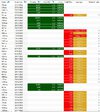MovingAverage
Just a retail hack
- Joined
- 23 January 2010
- Posts
- 1,315
- Reactions
- 2,565
@Skate what's the basis of your profit exit? Are you just using x% above entry price and are you also doing profit exits intra bar (not just exit on next days open)?
So many questions--what universe of stocks are you trading? Have you done any proper MC analysis on that system as I'd love to see the spread.
@Skate what's the basis of your profit exit? Are you just using x% above entry price and are you also doing profit exits intra bar (not just exit on next days open)?
@MovingAverage those are all valid questions. I only trade the "XAO". In response to your idea of ditching a traditional "Index Filter" I posted an alternative demonstrating by using a stock's "Relative Strength" of a stock's "price-performance" versus the index means only new positions that are making new highs within a consolidation period are selected.
Profit exit
I use a "take profit stop" using a weekly (ATR) multiplier measured bar-by-bar, simple & effective. The "Frogs on Toast" weekly strategy is a handy strategy that I have been trading for some time. The link I posted in the Amibroker forum is a way to plot the (RSL) which is handy to some degree but useless as a trading strategy. I'm just throwing ideas out there that I use as a way to answer questions or promote an old idea by making it new again.
Trailing Stop
The fallback "trailing stop" that is traditionally used in most strategies is rarely hit in the "Frogs on Toast" weekly strategy. By only selecting positions with a close above an upward sloping (RS) line means that the stock's price is outperforming the Index which can lead to a powerful breakout. Also using a unique "Stale Exit Stop" helps in getting exiting a position quickly which is also a nice feature of this strategy.
Skate.
@Skate let me come back to the point I raised earlier about using the MA slope gradient as an index filter...I may have missed it but does frogs on toast use that technique?@MovingAverage let me beat you to the punch
So there is no "cherry-picking" I've used a backtest comparison for this financial year (1/7/2021 to the end of trade today) My apologies to @qldfrog for the strategy name (it's the name of an old musical band).
Important metrics
I have highlighted a few metrics in red for comparison. I should also say "The Platinum Strategy" is not a slouch by any means, even though the performance of the last 22 weeks has been lackluster.
View attachment 142251
Also
The (Net Profit %) as well as the (P&L for closed trades) should not be discounted in those metrics. The use of an (RSL) is food for thought rather than using a "Traditional Index Filter". Without @peter2 realising his way of selecting "pullbacks" incorporates the idea of selecting positions within a consolidation period. Whereas the (RSL) selects positions that are making new highs within a consolidation period.
Skate.
Norgate provide a number of these indicators and I've been incorporating a few of them into my system to see what impact they have...very early days for my evaluations but they seem to have a very positive influence on my systems' performance. Definitely worth taking a close look at.Another sentiment indicator worth considering is the % of stocks above an MA.
I really like the idea of incorporating a market sentiment indicator in our market filter rather than the popular moving average.
@Skate let me come back to the point I raised earlier about using the MA slope gradient as an index filter...I may have missed it but does frogs on toast use that technique?
Another idea to float here before it sinks out of consciousness. Relative strength could be quite valuable when used with a "stale" or timed based exit. I'd be happy holding rather than selling a position while the position remains relatively strong vs the index. Once this relative strength disappears then I'd be happy to sell it.
A stale exit would have both a momentum component and a relative strength component.

Isn’t a risk with that approach that whilw the stock itself might be in a good up trend if the index momentum picks up (even though the stock’s trend remains solid) the relative strength will decrease forcing an early exit? Or am I missing somethingAnother idea to float here before it sinks out of consciousness.
Relative strength could be quite valuable when used with a "stale" or timed based exit. I'd be happy holding rather than selling a position while the position remains relatively strong vs the index. Once this relative strength disappears then I'd be happy to sell it.
A stale exit would have both a momentum component and a relative strength component.
You've got it right. The index could go up while the stock trade price remains steady. The combination of the paused momentum and the now weaker relative strength will trigger the stale exit. (@Skate has other criteria in his stale exit, eg ROC). The exit under these conditions isn't a forced early exit, rather a planned (enforced) correct stale exit.Isn’t a risk with that approach that whilw the stock itself might be in a good up trend if the index momentum picks up (even though the stock’s trend remains solid) the relative strength will decrease forcing an early exit? Or am I missing something
All trading carries risk, but is the index potentially signaling an inability to hold above this key level over the near-term? - it will be interesting if it can put together a rally and breakout within the coming days, as this would likely open the door to a strong move higher. XJO seems unable to overcome the selling pressure around 7200, although it isn't all that surprising to see such a strong resistance form at this key psychological level.
I really like the idea of incorporating a market sentiment indicator in our market filter
I like this discussion

Hello and welcome to Aussie Stock Forums!
To gain full access you must register. Registration is free and takes only a few seconds to complete.
Already a member? Log in here.